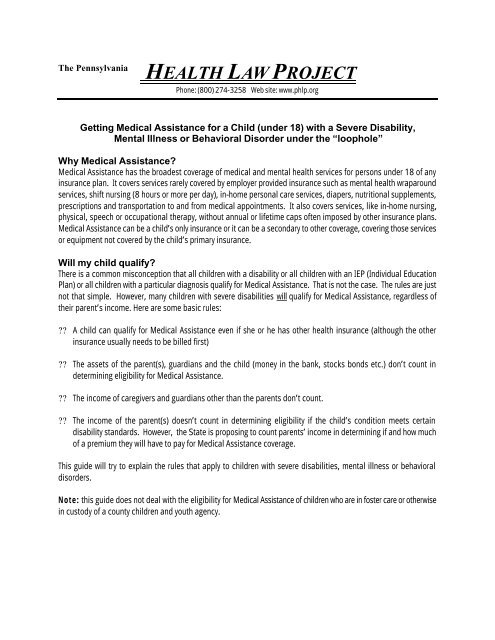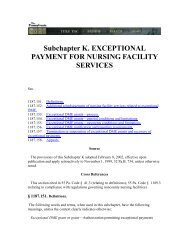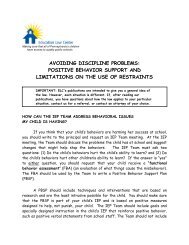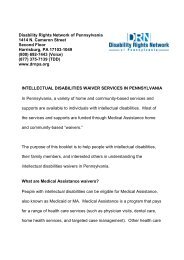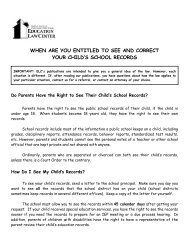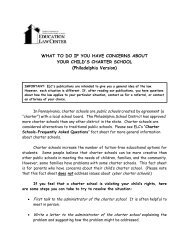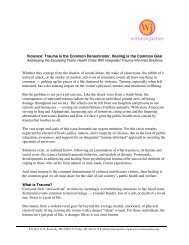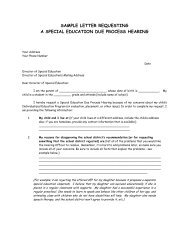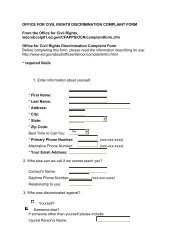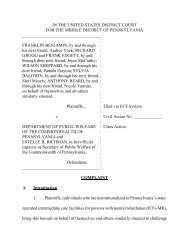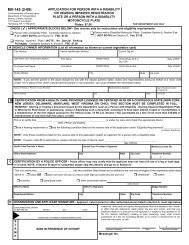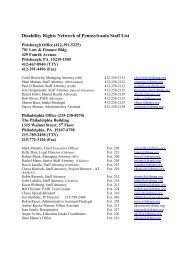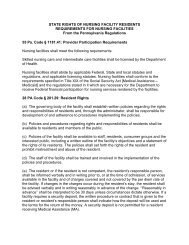HEALTH LAW PROJECT - Disability Rights Network of Pennsylvania
HEALTH LAW PROJECT - Disability Rights Network of Pennsylvania
HEALTH LAW PROJECT - Disability Rights Network of Pennsylvania
- No tags were found...
Create successful ePaper yourself
Turn your PDF publications into a flip-book with our unique Google optimized e-Paper software.
The <strong>Pennsylvania</strong><strong>HEALTH</strong> <strong>LAW</strong> <strong>PROJECT</strong>Phone: (800) 274-3258 Web site: www.phlp.orgGetting Medical Assistance for a Child (under 18) with a Severe <strong>Disability</strong>,Mental Illness or Behavioral Disorder under the “loophole”Why Medical Assistance?Medical Assistance has the broadest coverage <strong>of</strong> medical and mental health services for persons under 18 <strong>of</strong> anyinsurance plan. It covers services rarely covered by employer provided insurance such as mental health wraparoundservices, shift nursing (8 hours or more per day), in-home personal care services, diapers, nutritional supplements,prescriptions and transportation to and from medical appointments. It also covers services, like in-home nursing,physical, speech or occupational therapy, without annual or lifetime caps <strong>of</strong>ten imposed by other insurance plans.Medical Assistance can be a child’s only insurance or it can be a secondary to other coverage, covering those servicesor equipment not covered by the child’s primary insurance.Will my child qualify?There is a common misconception that all children with a disability or all children with an IEP (Individual EducationPlan) or all children with a particular diagnosis qualify for Medical Assistance. That is not the case. The rules are justnot that simple. However, many children with severe disabilities will qualify for Medical Assistance, regardless <strong>of</strong>their parent’s income. Here are some basic rules:?? A child can qualify for Medical Assistance even if she or he has other health insurance (although the otherinsurance usually needs to be billed first)?? The assets <strong>of</strong> the parent(s), guardians and the child (money in the bank, stocks bonds etc.) don’t count indetermining eligibility for Medical Assistance.?? The income <strong>of</strong> caregivers and guardians other than the parents don’t count.?? The income <strong>of</strong> the parent(s) doesn’t count in determining eligibility if the child’s condition meets certaindisability standards. However, the State is proposing to count parents’ income in determining if and how much<strong>of</strong> a premium they will have to pay for Medical Assistance coverage.This guide will try to explain the rules that apply to children with severe disabilities, mental illness or behavioraldisorders.Note: this guide does not deal with the eligibility for Medical Assistance <strong>of</strong> children who are in foster care or otherwisein custody <strong>of</strong> a county children and youth agency.
Eligibility requirements for Category PH 95, a.k.a. “loophole”?? Age: Under 18. Note: At age 18, parental income is no longer counted for SSI. Therefore, a child who hadbeen on MA under the loophole must apply for SSI at age 18, even if they had been turned down previously.However, a person with severe disabilities age 18 or older may still qualify for Medical Assistance under adifferent category (called Healthy Horizons) if they are turned down for SSI due to having countable assets over$2000 or due to having too much income <strong>of</strong> their own.?? <strong>Disability</strong>: Child must meet the Social Security disability guidelines (more about that later).?? Resources (assets): Not considered (neither the parent’s nor the child’s).?? Income: Income <strong>of</strong> the parents or other caregivers is NOT counted. However, income which is legallyconsidered to be the child’s IS counted. The more common types <strong>of</strong> income which is counted (because they areconsider to be the child’s) are listed below. Having countable income does not disqualify a child from MedicalAssistance, so long as the amount <strong>of</strong> the income does not exceed the income maximum. The maximum amount<strong>of</strong> countable income a child with severe disabilities can have and still get Medical Assistance is $817 a monthfor the year 2006 (it goes up some each year).What income is counted:oooInterest or dividends on bank accounts, stocks, bonds, cds or other investments which are in the child’sname (reported to the IRS under the child’s Social Security number). The principal (the amount on which theinterest or dividend is paid) is not counted (its considered a resource which is exempt).Earnings from child’s job: If the child is working, a portion <strong>of</strong> those earnings are counted. However, achild that earns enough to be over the income limit would probably not qualify for Medical Assistance underthis category anyway because they probably would not meet the disability guidelines. Call us for moreinformation if the child is employed at 1-800-274-3258.Trust funds: the rules about how trust funds affect Medical Assistance eligibility depend on how the trustis set up and are too complex to set out here.What income is not counted:ooCourt ordered child support: Medical Assistance used to count child support payments on the groundsthat child support was legally income to the child, not the parent (and only parental income is disregardedunder the loophole). However, effective September 1, 2000, Medical Assistance no longer counts childsupport for children who meet the disability standards provided the support is court ordered (it remainscounted for non-disabled children). This change is documented in Operations Memorandum 000-806revised 09-01-00 issued 8-31-2000 effective 9-1-00.Inheritances & payouts on life insurance policies: These can be counted as resources, rather thanincome. Medical Assistance Eligibility Handbook §319.62 (note on p. 319-11). The advantage to childrenin having this money considered as a resource is that there is no resource limit for anyone under 21.2
Therefore inheritances & payouts on life insurance policies should not affect Medical Assistance eligibilityfor anyone under 21.oSocial Security: “child’s benefits” or “survivors benefits” (not SSI) which are based on the pastearnings <strong>of</strong> a deceased, disabled or retired parent had been but are no longer counted. DPWOperations Memorandum OPS041001 , (10/4/04)The application process for Category PH 95 (loophole)Application is made at the County Assistance Office in the county where the child resides.1. Get an SSI eligibility determinationSSI (Supplemental Security Income) is a program administered by Social Security that provides a monthly check andMedical Assistance to persons who meet Social Security’s disability criteria and have low incomes and assets. Evenif the family is not seeking SSI, screening for eligibility for SSI is required by state regulations (55 Pa. Code§141.21(n)(2)) when Medical Assistance is sought for a child under the PH 95 (loophole) category if the child ispotentially eligible for SSI due to disability or medical condition. Unlike Medical Assistance under the loophole,parental (and stepparent) income and assets DO count in determining eligibility for SSI. However, Medical Assistancewill not be denied if parental income or assets exceed the SSI limits. Therefore, it is sufficient to get an denial for SSIfrom Social Security so long as the denial is on the basis <strong>of</strong> income or assets- not because Social Security hasdetermined the child does not meet their disability requirements. The SSI eligibility screening can be done with asimple phone call in most cases. To get a determination as to whether the child meets the income and resourcerequirements, you should do the following:?? Call Social Security at 1-800-772-1213. When you hear the recorded message, press 0 then, when thenext message comes on, press 1. You will get a live Social Security representative. The parent/guardianshould ask the Social Security representative that they would like to have an appointment set up for an SSIeligibility screening over the phone. The representative will give you a date and time when a representativefrom your local Social Security <strong>of</strong>fice will call to take the necessary information.?? Remember that parent’s and stepparent’s income and assets count for SSI so be sure to have pay stubs,bank statements and other income and resource records available on the date Social Security calls back.?? If the Social Security representative determines that the parent/stepparent/child’s income or resourcesare over the SSI limits, ask the representative to send a written letter to that effect. Keep that letter tosubmit to the County Assistance Office as pro<strong>of</strong> that the child was denied SSI.If the child had been on SSI recently (in the last year or so) and was terminated due to parental income or resources<strong>of</strong> the parent(s) or child, the County Assistance Office will usually accept the fact that the child had been on SSI aspro<strong>of</strong> the child meets the Social Security disability standards so long as the child was not terminated on grounds thathe/she was no longer disabled.Tip: If the child was terminated on the grounds that he/she no longer meets the disability standards, it is essentialthat the parent/guardian appeal the SSI termination (they have 65 days from the date on the SSI termination notice3
to do so). Otherwise, the determination <strong>of</strong> Social Security that the child does not meet the disability standards will bebinding on Medical Assistance and the child will not qualify under category PH 95.What if I call Social Security, and find that my child qualifies for SSI?In some cases, the parent/stepparent/child’s income is within the SSI limits. In that case, the parent will have to filea full SSI application at their local Social Security <strong>of</strong>fice and Social Security will determine whether the child meetsthe disability guidelines. To find the closest Social Security Office, call 1-800-772-1213 or go tohttps://s3abaca.ssa.gov/pro/fol/fol-home.html on the web. See the section before on SSI. Note that if SocialSecurity determines that the child does not meet the disability guidelines, the child will not be eligible for either SSIor for Medical Assistance under the PH 95 (loophole) category although the child may be eligible under a differentcategory <strong>of</strong> Medical Assistance, like Healthy Beginnings, where disability is not a requirement but parental income iscounted. Therefore, if the child is found not to meet the SSI disability guidelines and does not qualify for MedicalAssistance under one <strong>of</strong> the “non-disabled” categories, it is critical that the parent/guardian appeal Social Security’sdecision.2. Get an application form or apply onlineTwo application forms are available - the PA600 (long form) and PA600CH (“Application for Health Care Coverage”).It is strongly recommended that the parent/guardian use the PA 600CH form. You can obtain the form by calling 1-800-986-5437. You can also download the application form from the web at:http://www.dpw.state.pa.us/Resources/Documents/Pdf/FillInForms/PA600.pdf. To print out the application <strong>of</strong>fthe web you will need Adobe Acrobat reader. It is free. Go to http://www.adobe.com/products/acrobat/readstep2.htmlto download this extremely useful application. You can also apply online athttps://www.humanservices.state.pa.us/COMPASS/.3. Fill out the application formFor the PA600CH, start on page 3.The parent/guardian puts their name in Part I on page 3 (at bottom).?? Page 4: On the top line <strong>of</strong> the 4 th page (part II), put the parent/caregiver’s name. On that same top line,check the NO box in the column “Are you Applying for this Person”. On line 2 (“Person 2”), list the child’sname for whom the application is being made and be sure to check the YES box in the column “Are youApplying for this Person” on the line where the child’s name is. If you are applying for more than one child,list the other child(ren) on the following lines. Information about a stepparent is also requested. If the childfor whom you are applying has a stepparent at home, put in the stepparent’s name at the bottom <strong>of</strong> thepage (after “Are you, or is anyone who lives with you a stepparent?”)?? Page 5: The top <strong>of</strong> Page 5 asks for income by source (part III). Under a new state law, income <strong>of</strong> theparent(s) must be listed here- even though it is NOT counted in determining the eligibility <strong>of</strong> the child(provided the child meets the disability requirements). Income <strong>of</strong> stepparents need not be reported.?? Put in the amount <strong>of</strong> Social Security or child support, if any, received for the child for whom the applicationis being made in the applicable box and put the child’s name in the box “Whose income is this?”.Remember that court ordered child support will not effect the child’s eligibility. If there are any bankaccounts or other investments listed under the child’s name or reported to the IRS under the child’s SocialSecurity number, report the interest or dividend that has accrued and the time period during which it has4
The standards vary depending on the “body system” that is affected by the disability or condition. You will need t<strong>of</strong>ind the body system that is affected by your child’s disability/condition to determine which <strong>of</strong> the standards apply.However, as a general rule <strong>of</strong> thumb, the disability standards consider the extent to which the child’sdisability/condition limits the child’s ability to perform basic functions (appropriate for his/her age group). Thesebasic functions include physical and neurological functioning (ability to walk, talk, feed oneself etc.), sensoryfunctioning (ability to see or hear), cognitive functioning (ability to learn and understand) and psychologicalfunctioning (ability to develop and maintain relationships with others, avoid violent behavior and dangeroussituations etc.).A parent/ guardian should not try to determine whether their child’s condition meets the Listings. The usefulness <strong>of</strong>the Listings to parents is to determine what they will need to document. In most cases, it is necessary to documentthe nature, severity, frequency and duration <strong>of</strong> the limitation(s) in addition to the medical or psychiatric condition thatcauses the limitation(s). Important sources <strong>of</strong> documentation include: the child’s doctors, therapists, teachers,guidance counselors and school records (including the Comprehensive Evaluation Report, the MultidisciplinaryEvaluation or “MDE”, report cards and attendance records) IEPs are not enough because they focus on educationalissues which are not the primary focus <strong>of</strong> the Social Security disability standards. For more information regarding the“listings <strong>of</strong> impairments” that apply to children with mental illnesses or bio-neurological conditions, ask us for theguide on that topic.8. Filing the applicationThe application needs to be filed at your local County Assistance Office unless you have filed online(https://www.humanservices.state.pa.us/COMPASS/ ) You can find the location and phone number <strong>of</strong> your CountyAssistance Office in the blue pages <strong>of</strong> the phone directory under “Government & Other Public Services- PublicWelfare” or on the web at: http://www.dpw.state.pa.us/general/dpwcao.asp . The application can be filed bymailing it or by taking it to the County Assistance Office in person. If mailing, send it certified or get a mailingcertificate to prove when you mailed it. If you are dropping it <strong>of</strong>f at the County Assistance Office, ask for a receipt.Filing by mail- There are 2 options:A) Send in only the application form. This will usually result in getting a call or notice from the County AssistanceOffice to schedule an “intake” appointment at the County Assistance Office. Sometimes a worker from the CountyAssistance Office will conduct a “screening interview” over the phone.NOTE: If, during the screening interview, the worker indicates that the child is not eligible, the parent/guardianshould insist that the application process be completed or else he/she may have waived their appeal rights. At theintake appointment, the parent/guardian must bring in the necessary documentation (see below).B) Request that the intake appointment be waived. Under this option, the application is processed based on thedocuments submitted, without the need to go into the County Assistance Office. In order to do this, theparent/guardian needs to submit a completed and signed application form along with all necessary documentation(see below).The application and documentation should include a cover letter with the following sentence: “I am requesting thatthe face-to-face interview be waived pursuant to Medical Assistance Eligibility Handbook sections 304.4 and 378.3.Please contact me at [daytime phone #] if additional information or documentation is needed.”6
Authorization to Release Information- Form PA 4Caseworkers will usually insist the parent/caregiver sign a blanket release form which allows DPW to contactemployers, banks, etc. to obtain financial information relevant to the child’s application for Medical Assistance.State regulations require a parent/caregiver to sign this release form in regards to “information about…the applicantor recipient….” 55 PA. Code §201.4 (1)(ii). State regulations state that “the applicant” includes “The adult withwhom an unemancipated minor lives….” 55 PA. Code §123.82. Therefore, the parent/caregiver is legally obligatedto sign the PA 4 form to release information regarding both the child and the parent, even though parental incomeand assets are not relevant. Of course this is a conflict in the law since the Medical Assistance Eligibility Handbooksays parental income and resources don’t count. Unfortunately the requirements to sign the PA 4 are in regulationswhile the “loophole” provisions are only in the Handbook and the regulations take precedence over the Handbook.What happens next for Medical Assistance?Determining disabilityOnce the application and necessary documentation has been submitted, the caseworker at the County AssistanceOffice has authority to immediately find that the child meets the disability standards, pending a final decision by theMedical Review Team (which takes months), if, based on the documentation provided by the parent/guardian, thechild “appears to be disabled”. This is authorized by Medical Assistance Eligibility Handbook §305.26. This is knownas “presumptive eligibility” and is very common if good documentation is provided. If the caseworker doesn’t feelcomfortable making the “presumptive eligibility” disability determination him/herself, ask the caseworker to transferthe case to the “DAP Unit” (<strong>Disability</strong> Advocacy Program Unit) at the County Assistance Office. The DAP Unit iscomprised <strong>of</strong> workers specially trained in the disability standards. They will usually review the medical or psychiatricdocumentation, and may request that the parent/guardian get additional documentation or come in for an interview.If the caseworker or the worker from the “DAP Unit” finds the child “presumptively eligible”, the caseworker canauthorize Medical Assistance immediately. A Medical Assistance ID card (a.k.a. “Access Card”) should arrive in 1 to2 weeks. If the child needs services under Medical Assistance before that, the parent/caregiver should ask thecaseworker for the child’s Medical Assistance ID#, card issue #, category and program status code. With thosenumbers, most providers are willing to start serving the child under Medical Assistance without waiting for the <strong>of</strong>ficialID card (“known as the Access card). If the provider insists on an <strong>of</strong>ficial card, the parent/caretaker can request an“Interim Medical Card” from the caseworker at the CAO. An Interim Medical Card can be done in a day. Thecaseworker cannot require documentation <strong>of</strong> a medical appointment. The statement <strong>of</strong> the parent/caregiver thatthere is an immediate need for the card is sufficient. Medical Assistance Eligibility Handbook §380.4.Once the case has been authorized, the caseworker is supposed to transfer the case to the DAP Unit to review themedical or psychiatric documentation if they have not already done so. After that, the DAP Unit is supposed to sendthe documentation to an agency under contract with Medical Assistance, know as the Medical Review Team (“MRT”)which makes the final decision as to whether the documentation shows that the child meets the disability standards.If the MRT decides that the child’s documented condition does not meet the disability standards, the CountyAssistance Office will terminate the child’s Medical Assistance unless the child is eligible under another category.However, the parent/caregiver can appeal the MRT’s decision and if their appeal is received by the County AssistanceOffice within 10 days <strong>of</strong> the termination notice being mailed, the termination cannot go through until after the familyhas had a hearing and gets a hearing decision. (Of course, if the parent/caretaker wins, the termination won’t gothrough at all.) The termination notice explains how to appeal.9
Enrollment in an HMOChildren living in the following counties will be required to enroll in an HMO that has a contract with MedicalAssistance: Allegheny, Armstrong, Beaver, Bucks, Butler, Chester, Delaware, Fayette, Greene, Indiana, Lawrence,Montgomery, Philadelphia, Washington, Westmoreland, Adams, Berks, Cumberland, Dauphin, Lancaster, Lebanon,Lehigh, Northampton, Perry and York. This is required even if the child has other health coverage, including anotherHMO. The services the child needs (other than behavioral health services) are then obtained through the HMO, ratherthan through Medical Assistance itself, although the HMO must cover all the services regular Medical Assistancecovers. The requirement that a child living in one <strong>of</strong> the counties listed above be enrolled in one <strong>of</strong> the MedicalAssistance HMOs applies even if the parent/caregiver is only seeking coverage for behavioral health services, eventhough the Medical Assistance HMO does not directly provide that coverage. Children who can be covered by anemployer-sponsored health insurance plan if the parent pays (or has deducted from their pay) a monthly premium,may be eligible for “HIPP program” (the health insurance premium payment program) under which MedicalAssistance pays the premium to have the child covered under the employer sponsored health plan. In that situation,the child would be disenrolled from the Medical Assistance HMO.For children living in the counties above, coverage for behavioral health services comes through a separate entitycalled a “Behavioral Health Managed Care Organization” which has a contract with the county MH/MR agency.Medical Assistance HMOs are also in operation in several other counties besides the ones mentioned above.However, in those other counties enrollment in one <strong>of</strong> these Medical Assistance HMOs is voluntary.3/20/0610


